| Pentax/Camera Marketplace |
| Pentax Items for Sale |
| Wanted Pentax Items |
| Pentax Deals |
| Deal Finder & Price Alerts |
| Price Watch Forum |
| My Marketplace Activity |
| List a New Item |
| Get seller access! |
| Pentax Stores |
| Pentax Retailer Map |
| Pentax Photos |
| Sample Photo Search |
| Recent Photo Mosaic |
| Today's Photos |
| Free Photo Storage |
| Member Photo Albums |
| User Photo Gallery |
| Exclusive Gallery |
| Photo Community |
| Photo Sharing Forum |
| Critique Forum |
| Official Photo Contests |
| World Pentax Day Gallery |
| World Pentax Day Photo Map |
| Pentax Resources |
| Articles and Tutorials |
| Member-Submitted Articles |
| Recommended Gear |
| Firmware Update Guide |
| Firmware Updates |
| Pentax News |
| Pentax Lens Databases |
| Pentax Lens Reviews |
| Pentax Lens Search |
| Third-Party Lens Reviews |
| Lens Compatibility |
| Pentax Serial Number Database |
| In-Depth Reviews |
| SLR Lens Forum |
| Sample Photo Archive |
| Forum Discussions |
| New Posts |
| Today's Threads |
| Photo Threads |
| Recent Photo Mosaic |
| Recent Updates |
| Today's Photos |
| Quick Searches |
| Unanswered Threads |
| Recently Liked Posts |
| Forum RSS Feed |
| Go to Page... |
PentaxForums.com → Digital Cameras → DSLR-Specific Forums → Pentax K-1 & K-1 II
→
Two things I don't like about the K-1 C-AF performance
 |
| Search this Thread |
| 11-14-2017, 02:22 AM | #46 |
 The D500 is a specialist camera too expensive for most people. It's more than fifty percent more expensive than the premium Pentax crop camera, the KP, and almost makes no sense when you can get a full frame K-1 for the same price! You're supporting that primitive image recognition system of 3D Tracking more than Nikon themselves do - they do not recommend it in their documentation, as DPR have pointed out. Have a look at the Nikon 3D tracking jump around before totally disintegrating on the woman in this clip ... | |
| 11-14-2017, 02:29 AM - 1 Like | #47 |
| Great! This doesn't mean everyone can do this, that is why he is *the* action photographer. AND how many takes could he have? How much planning went into deciding where the skateboarder was going to be. Did he practice his focus ranges and establish his focus limits. How much experience does he have taking these kinds of shots? Such shoots become the very definition of non-erratic, because he knows his subject, his gear, and that makes him a pro.. Below are two shots I did, the first just last weekend with my newly acquired Canon FD 300mm f2.8 on a Sony A7. Corey chose manual focus because the Nikon D5 autofocus wouldn't be able to track his skateboarder. Of course you practice your focus range, it's no different from chimping an exposure, if I can do it, you can! | |
| These users Like clackers's post: |

| 11-14-2017, 02:29 PM - 1 Like | #48 |
| Have a look at the Nikon 3D tracking jump around before totally disintegrating on the woman in this clip ... NIKON D750/D4 3D Tracking Auto Focus - YouTube  As the person is moving towards the camera the sweater line is dropping lower and lower in the frame. The camera selects different sensors surrounding the line, while it considers where the system expects the target will be as well as where the most contrasting lines will be. Here is an example where the camera is switching from one sensor to the next. Look at the gap in the sensor indicator space:  These sensors look something like this (This is a 16 sensor unit):  The D750 in the video is a 51 sensor group and they are often lined up like this:  So, even though the display shows you a massive jump, the sensors often are right next to each other. To actually know where the sensor is, you need to measure it. So the crazy jumping is actually what you should expect as the subject moves across the frame. In the Nikon D500 there are a 153 focus points. 55 are selectable. When you get an indication that a specific sensor is being used in the D500, it might actually be the one of the surrounding supporting sensors that are used. The squares are what you see when they indicate which sensor is used, but the dots are where the other sensors are. So just following the visual aid square is not an accurate way of knowing what the camera is actually tracking. 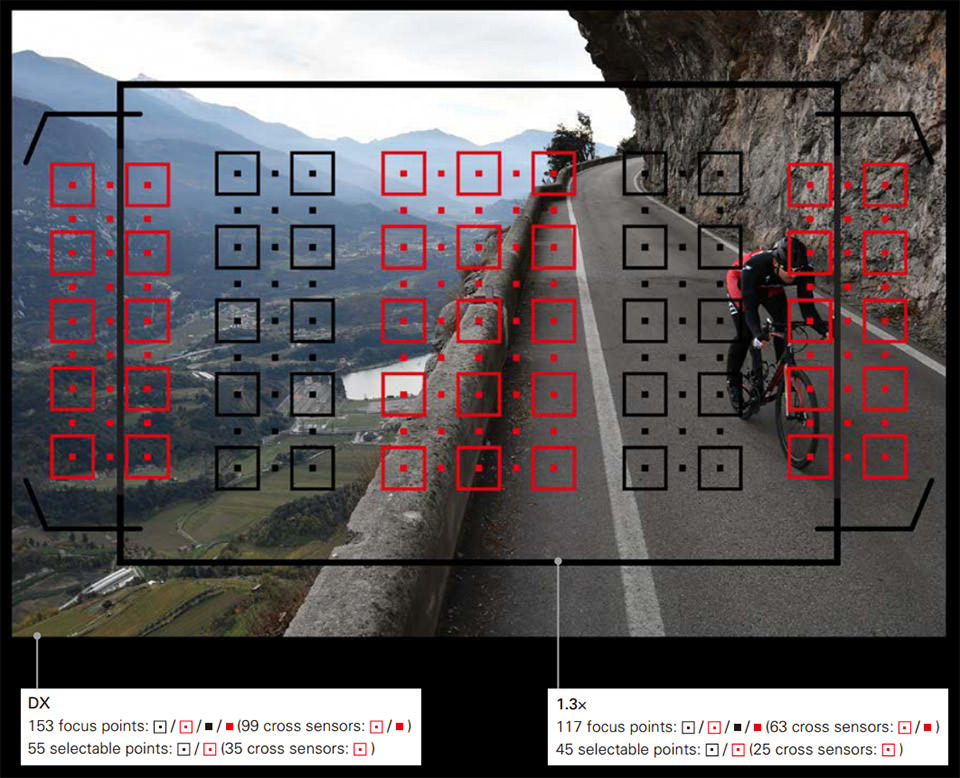 Keep in mind that the tracking is done by the metering sensor. These sensors range from 2000 pixels up to 180k pixels. This sensor is used to establish the contrasting lines that will be tracked and selects the phase detection sensor that best fits this location. On my Nikon D3000 it looks horrible when it is tracking a subject. The red squares are jumping all over the place, yet I get 41% retention rate with a depth of field ranging from 0.4 meters to 0.08 meters on a dog running towards me. Knowing this, you can look at the video again and see that the squares are always around that bottom white line of the sweater. What might be more interesting is to hear from you what you thought it should look like? ---------- Post added 11-14-17 at 03:22 PM ---------- You have an odd view, Jeff - that only pros can manual focus! Below are two shots I did, the first just last weekend with my newly acquired Canon FD 300mm f2.8 on a Sony A7. Of course you practice your focus range, it's no different from chimping an exposure, if I can do it, you can! This is a great way to improve your own technique! I agree! ... One additional note, most action shots where the subject is moving towards the camera, can become extremely boring real quick. Action shots usually means something when the subject interacts with what ever the action is (such as the environment), unless there is something interesting about the subject alone. So getting more in focus (larger DOF) will usually make the shot more interesting. Clackers, you are in the prime situation to provide us with additional information. You have two camera system that can now be compared with each other. What would be helpful is to setup a more controlled situation. Why not try this: Setup a very small DOF configuration, relative to your subject, with an erratic target, in the Z-Axis. Take a 100 shots with each camera, upload the raw files (the whole set, including bad and good ones) and let us examine what the retention rate is? Additionally try another 100 shots with the Sony A7's tracking turned on. This would be helpful information. Because if you get a retention rate of 60% with the Pentax and then a 40% retention rate with the Sony, then we know that with how you use the camera the Pentax is a better solution. (I am skeptical of mirror-less cameras being the best auto-focus systems out there, because phase detection is a proven technology). Why is this important? Well the Original Poster had this scenario: It isn't good enough to show low res pictures of how you did this (your success stories). What are the settings? Show us small-DOF full-res picture sequences where you were able to do this? I can also show my success stories. Look at these: Flickr Album. Here is one of my best (BTW, you can click on the image and get the full res image and see how tight the DOF is! Be sure to zoom in to a 100%):  Look at how small the DOF is! But I am honest and can tell you that it took a lot of shots to get one of these with the Pentax K-1. Here is the Nikon D3000 picture. With tracking on the Nikon D3000 on (which is horrible), I got this within 27 shots:  It isn't an interesting shot, but having that ability in your toolbox is great for when it might be interesting, such as a kid's facial expression, while they are running! | |
| These users Like Jeffvan's post: |

| 11-15-2017, 09:28 PM | #49 |
| I don't think there's a point fetishizing the expensive D5's system ... take away the hype, and DPR found 3D tracking is something uncritical and unskeptical readers might get excited reading about, but it has real problems when shooting, and you need to use a conventional mode instead. The DPR writer talks up the feature, but in the link below look for yourself at the failure of the Nikon system to track the player's elbow in the shots - click on the buttons labelled 1,2,3 and so on under each picture. The focus point aggressively shifts to other body parts in the player, another player, and even the uniformly dark background. It's baffling when AFAIK there's a second CPU the owner has paid for on the D5 motherboard that's in charge of this algorithm. What is its excuse for failing to keep up, and why does it choose something that looks nothing like the subject as its target? As a gloomy Pentaxian, I expected better AF from the Canon 5D Mk III and Nikon D810 on the days I used them ... but I thought, 'Meh'. What was I supposed to be impressed by? The D5 (it and the D500 have much the same AF system) are enormously priced specialist cameras but you can see from the sequences they just can't replace a skilled photographer. Link: https://www.dpreview.com/reviews/nikon-d5-pro-dslr-review/11 Last edited by clackers; 11-15-2017 at 09:35 PM. | |
| 11-15-2017, 09:33 PM | #50 |
| With taking pictures of bowlers in cricket, you can easily increase the DOF, setup your focus for where your subject is going to be (with bowlers in cricket this is easy since you have at least 60 bowls per bowler and they try to bowl as close to the line) and then take your pictures. This picture is a great example of what I suggested: Know your subject, increase your DOF to include the interesting environment.  As in the situation where you said I took pictures of a female runner on the beach at f8, you were wrong. It was at f4. And with the cricketers above, there was no 'increasing the DoF'. That Canon lens is *wide open* at f2.8. Here is another shot, soccer players at f2.8 taken a few weeks ago with the Tamron 70-200 on the K-1 ... Last edited by clackers; 11-15-2017 at 09:42 PM. | |
| 11-15-2017, 10:44 PM | #51 |
| Of course they're errors in the system, Jeff, failing to track what they're supposed to track. The doll's eye only returns to focus because the photographer had to come to rest to allow it. I don't think there's a point fetishizing the expensive D5's system ... take away the hype, and DPR found 3D tracking is something uncritical and unskeptical readers might get excited reading about, but it has real problems when shooting, and you need to use a conventional mode instead. The DPR writer talks up the feature, but in the link below look for yourself at the failure of the Nikon system to track the player's elbow in the shots - click on the buttons labelled 1,2,3 and so on under each picture. The focus point aggressively shifts to other body parts in the player, another player, and even the uniformly dark background. It's baffling when AFAIK there's a second CPU the owner has paid for on the D5 motherboard that's in charge of this algorithm. What is its excuse for failing to keep up, and why does it choose something that looks nothing like the subject as its target? As a gloomy Pentaxian, I expected better AF from the Canon 5D Mk III and Nikon D810 on the days I used them ... but I thought, 'Meh'. What was I supposed to be impressed by? The D5 (it and the D500 have much the same AF system) are enormously priced specialist cameras but you can see from the sequences they just can't replace a skilled photographer. Link: Setting new standards: Nikon D5 Review: Digital Photography Review My suggestion wasn't that everyone needs to go get a D500 or D5. My suggestion was that if you plan on doing a lot of action shots, you might get a lot more out of a camera that has a better focusing system. That includes a better 3D tracking system. It gives you options, sure you might not always want to use 3D tracking. But on erratic targets, it can help a lot! This is DPReviews full writeup on the 3D tracking. I will let the Review speak for itself and others can decide.: 3D Tracking With soccer, the D5's 3D Tracking performance far exceeded my expectations. I used slightly different settings than Nikon's recommendation for Dynamic-area, setting 'Blocked shot AF response' to 3 and subject movement to 'erratic.' With that setup, if I successfully initiated autofocus on my subject, the camera tracked impressively well, keeping the point over the subject as they moved around the frame. Even during bursts, which is not necessarily my experience with lower end, non-Dx series bodies like the D810. This let me follow my subjects a little less carefully than if I was following them with a manually picked point, and also freed up my compositions a little bit. What's most surprising, though, is how tenaciously 3D Tracking would stick to my subject when it was completely blocked by another player. It remembers. My experience largely mirrored that of our Tech Editor, Rishi, who despite it being his first rugby game ever, came back with an enormous number of hits simply using 3D Tracking to specify his subject, then firing away while following, somewhat imprecisely he'd add, erratically moving players at 300mm. But that's not say that 3D Tracking is completely infallible. When the camera loses the subject, you may find yourself re-framing and re-initiating quickly, but luckily the D5 is really quick at that re-initiating part (focus acquisition is fast). Sometimes though, you just end up with this: Admittedly, in the above images, 3D Tracking had a lot working against it. A dark subject, backlit, on a dark background. In any case, you can see how the camera decided to start tracking the player closer to the camera (possibly anticipating movement of the existing subject, possibly influenced by the backlighting), rendering the original subject out-of-focus by the time he decided to kick the ball. So there's the rub. Despite how well 3D Tracking works, it is fallible in certain situations. It also does slow down, and get more inaccurate, in lower light. And let's just say for the sake of argument that the above play was a crucial one, and all I came back with was a shot with missed focus. That's not good. That's where 25-point dynamic area autofocus might come in handy. Comparing the Nikon D3000 with 3D tracking with the K-1 center spot focus, I found their success rate to be about the same. My conditions for the test was an erratic subject moving towards the camera with small DOF. Maybe I am wrong with my success rate calculation, but professional reviewers all comment on the "not-a-sports-camera" autofocus of the K-1's autofocus (even with a Pentax rep present, this point is not disputed). They say this not because you couldn't get action shots, with a K-1, but that other brands have better auto focus results. Maybe I should do an even larger pool of shots, with both cameras, to get more accurate rates. But that is what it would require, useful data, and lots of it. I looked for picture sequences that you posted, with small enough DOF that was visible in the picture (low res). With the one sequence I found (low res pictures), it appears that you might only be getting a 50% accuracy (without exif data it is hard to say if it was motion blur or actual auto focus). The Nikon D3000 is an old camera: I really think a D810 or even a D750 would out perform the Nikon D3000's auto-focus system. Last edited by Jeffvan; 11-16-2017 at 01:08 AM. | |
| 11-16-2017, 12:57 AM | #52 |
| IMHO, that's quite shaky guestimates and numbers you rely on Jeff.  As in the situation where you said I took pictures of a female runner on the beach at f8, you were wrong. It was at f4. And with the cricketers above, there was no 'increasing the DoF'. That Canon lens is *wide open* at f2.8. Here is another shot, soccer players at f2.8 taken a few weeks ago with the Tamron 70-200 on the K-1 ... But: You again show us a single success shot, at low resolution. It would be a lot more helpful to see a sequence of shots from a target moving erratically towards the camera, in full resolution (preferably Raw pictures, the exif data reveals a lot). It would also be great to see a very small DOF, relative to the subject, since we need to determine where the focus lands. Even better would be 100 or so shots composed of sequences; then we can actually calculate success rate. This is how you would asses the capability of any focus system. You could do this for 3D tracking, with or without movement in the direction of the camera. Or spot focus tracking and compare the results from the different methods. Or even smooth motion towards the camera, etc. You just need to define what your subject was doing, that is why sequence shots are great. Combine that with a small DOF and you can see what the camera is doing with the focus system. Here is an example of what I mean (click on the image to get full res pictures): 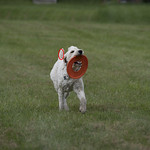 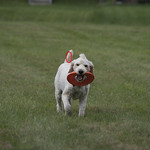 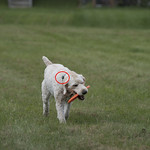 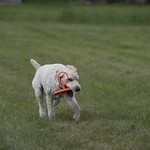  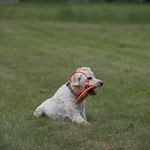 The red circles indicate where the focus is. With the sequence of shots we can see the dog is moving in the first 2 shots and starts to stop and settle down in shots 3 and 4. And then lays down in 5 and 6. These shots were the result of bad settings on the camera causing a shutter release delay, which effectively caused the focus system to lag behind. To know this you need a small DOF and a sequence of shots. Just as an example: If we were measuring success of the focus tracking of the K-1 in this scenario we need to disregard shots 4 through 6 since the dog isn't moving and we are interested in tracking. In shot 4 it looks like the dog is still running but it really is starting to lay down. If we increased our DOF (either by reducing the resolution or manipulating one of the 3 other variables that affect DOF) we could easily get the dog's face in focus. This would make determining where the focus lands difficult. But more importantly: Why not answer the question posed by the OP? I will state it again: | |
 |
| Bookmarks |
| Tags - Make this thread easier to find by adding keywords to it! |
camera, cycle, dof, dslr, feet, focus, full frame, full-frame, k-1, k1, line, nikon, pentax k-1, performance, sensor, shutter, subject, subjects  |
| Thread Tools | Search this Thread |
| |
 Similar Threads
Similar Threads | ||||
| Thread | Thread Starter | Forum | Replies | Last Post |
| Sen. Coburn (R-Hell): Medicare and SS 'Are things we don't absolutely need' | boriscleto | General Talk | 11 | 12-10-2012 02:10 PM |
| Landscape two big things - two little things | nickthetasmaniac | Post Your Photos! | 1 | 11-05-2011 07:51 AM |
| Things you don't want to hear your doctor say... | Hey Elwood | General Talk | 76 | 10-22-2009 06:02 AM |
| Money I don't have on things I don't need | daacon | Pentax SLR Lens Discussion | 5 | 12-13-2007 10:04 PM |


















